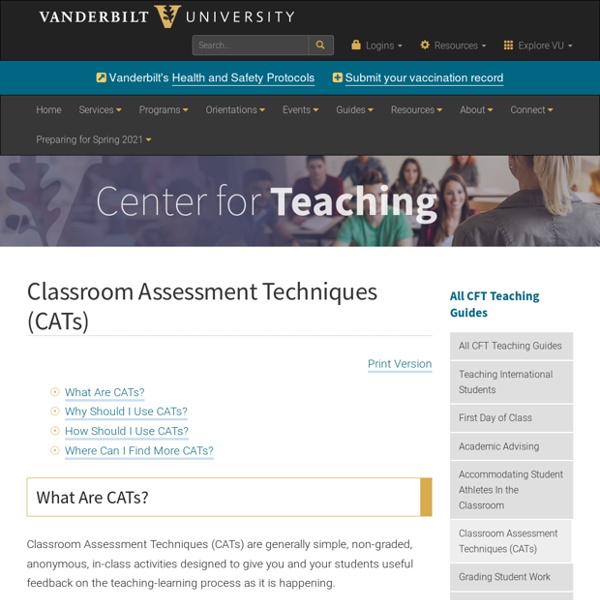



https://cft.vanderbilt.edu/guides-sub-pages/cats/
Related: Assessment Ideas • Teaching Websites and General Teaching Resources • Assessment • Remote LearningiTeachU – Content Curation Tools Content Curation ToolsJennifer Moss2014-05-13T14:38:01+00:00 What is Content Curation? As instructors, we are all information curators. How do you collect and share currently relevant content with your students? How do your students research and share information that they find with the rest of class? What tools do you use to manage or facilitate presentation of resources? Strategies for effective group work in the Online Class This is the second post in a three part series on group work in online learning communities. Post one, featured why we need group work in online learning, and post three will be on how to evaluate group work in online assignments. Quick recap – why oh why do we need to create opportunities for collaboration and structured learning in an online class?
Classroom Assessment Techniques (CATs) The following guide is designed to explain and give examples of how in-class assessment can enhance university teaching and learning. These techniques are based on the work of Angelo and Cross (1993). If you have questions about this material or would like to meet with the University Teaching and Learning Center, please e-mail utlc@gwu.edu. What Are CATs? Classroom Assessment Techniques (CATs) are, typically, ungraded activities conducted in the classroom setting. 7 Ways to Do Formative Assessments in Your Virtual Classroom Pen-and-paper pop quizzes are no more: thumbs-up/thumbs-down, hand signals, online polls, discussion boards, and chat boxes have become the new mainstays of formative assessments in virtual classrooms. These quick pulse checks help teachers make sure that students are grasping key concepts—and identify holes in their understanding. “Good teachers in every subject will adjust their teaching based on what students know at each point,” says Vicki Davis, a director of instructional technology in Albany, Georgia, underscoring how crucial ongoing formative assessments are in the classroom. Teachers don’t need to completely reinvent their traditional formative assessments, however, according to Mike Anderson, an educational consultant in Durham, New Hampshire.
CTE - What Do Students Already Know? Doing so is grounded in learning theories (Ausubel, 1968; Dewey, 1938) and is supported by research on the learning process (Tobias, 1994; Dochy, Segers & Buehl, 1999; Fisher, 2004). For students, understanding their starting point will make it easier for them to see what they have learned by the end of the course. They can better recall past learning and construct “bridges” between old and new knowledge (Angelo & Cross, 1993). Ambrose, S.
Should You Change Answers on Multiple-Choice Tests, or "Stick With Your Gut?" Should you change your answers on test questions? I’m going to spoil it right up front: In general, the answer is yes. Research has been conducted multiple times over the course of the last seventy years on this problem, and the results are clear. Most answer changes are from wrong to right, which means that most people who do choose to change answers will actually improve their test scores.
iPads Provide Dental Students with Fast, Formative Feedback on Clinical Performance - Teaching with Technology Last week, a new piece of equipment was introduced for the Panoramic Imaging exercise DMD students were expected to complete in The Dental Center. This particular piece of equipment was not a sophisticated CT scanner or other hi-tech imaging device, but a simple iPad programmed to provide students with a higher quality of formative performance feedback than had previously been possible. As with other tablet-based assessment projects IT has developed ( links to related articles at the end of this post), at least part of the incentive to develop such a tool was based on the time constraints of providing individualized feedback to students. A process that once took 3 to 4 minutes per student has been reduced to under a minute thanks to a combination of touchscreen technology and an ingenious set of performance rubrics designed give students more qualitative, meaningful feedback.
How K–12 Schools Monitor Attendance During Remote Learning With the rapid transition to remote learning, it’s been a trying time for many school districts across the country. After all, they’ve had a lot to figure out — from finding ways to bridge the digital divide to ensuring student security and privacy online. Another major challenge is maintaining student attendance. When the novel coronavirus pushed schools to close their doors and adopt a remote learning model, many educators saw a drop in class attendance, according to Education Dive. Thankfully, there are school districts that have found ways to tackle attendance during remote learning and conduct significant outreach to students and families who need it the most.